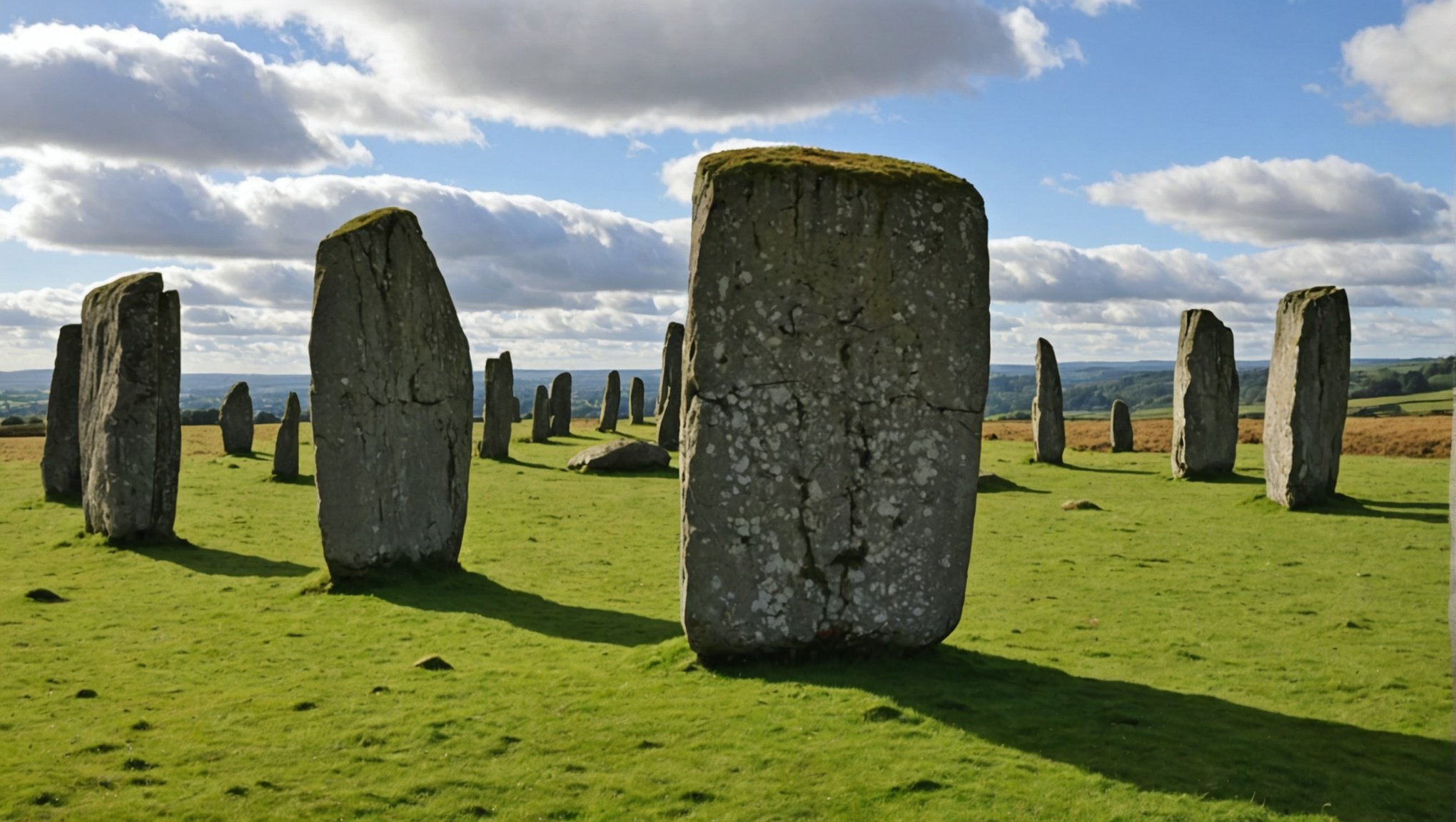Overview of Prehistoric Stone Circles in the UK
Prehistoric stone circles in the UK serve as ancient monuments with fascinating historical significance. These majestic structures offer a glimpse into the rituals and astronomical practices of early societies in the British Isles. The UK is especially rich in these stone circles, exceeding over a thousand, showcasing the remarkable ingenuity and communal efforts of ancient communities.
Although Stonehenge is the most renowned among these prehistoric stone circles, it should not overshadow the numerous lesser-known circles that hold their own charm and historical significance. While Stonehenge is distinguished by its massive megaliths and sophisticated alignment with celestial bodies, smaller circles often consist of modestly sized stones and lack such intricate engineering. Nonetheless, these sites carry mysteries of their own, shedding light on regional variations in construction techniques and cultural practices.
Additional reading : Discover Scotland’s Top Coastal Havens for Capturing Stunning Puffin Photos This Summer
The regional distribution of prehistoric stone circles spreads widely across the UK, with dense clusters in Scotland, northern England, and particularly in the southwest. Each region’s circles exhibit distinct characteristics and architectural styles, reflecting localized traditions and influences.
Understanding these ancient monuments as part of the broader network of UK historical sites enriches our comprehension of early human history and emphasizes the legacy of past civilizations in shaping contemporary cultural landscapes.
In the same genre : Discover the Best Locations to Experience a Traditional UK Hog Roast Delight!
Unique Guided Tours Available
Guided tours offer a structured way to explore new destinations, providing in-depth travel experiences that are both educational and enjoyable. Within the realm of adventure tourism, these tours stand out for their ability to immerse travelers in local culture and natural beauty, all while ensuring safety and convenience.
Overview of Tour Options
Exploring the diverse range of guided tours reveals an exciting variety of options designed to cater to different interests. Options range from historical city walks to thrilling outdoor adventures. For those seeking adventure tourism, there are tours that include activities such as hiking, kayaking, and wildlife safaris. These tours are not only about the destinations but also about the unique experiences they offer.
Top-Rated Tours and Reviews
When evaluating top-rated tours, feedback often highlights exceptional local guides and memorable travel experiences. Users commonly praise the depth of knowledge and enthusiasm of the guides, which enhances the overall journey. Reviews also emphasize well-organized itineraries that efficiently combine must-see sites with lesser-known gems, often creating an unforgettable adventure tourism experience.
Special Features of Each Tour
An integral part of these guided tours is the local guides whose expertise and insight greatly enrich the travel experience. Emphasis is also placed on accessibility, ensuring that amenities such as transportation and entry fees are inclusive in the package. This thoughtful consideration enhances the enjoyment and accessibility of the tour for all travelers.
Notable Prehistoric Stone Circles Beyond Stonehenge
Among prehistoric stone circles, Avebury and Callanish stand out as significant historical landmarks and tourist attractions, showcasing the mysterious and artistic endeavors of ancient civilizations. Avebury, located in Wiltshire, England, is one of the largest stone circle sites in Europe. Its massive stone structures are encircled by an enormous bank and ditch, offering insight into the Neolithic period.
In stark contrast, the enchanting Callanish Stones in Scotland’s Outer Hebrides serve as an iconic representation of early human settlement and spirituality. Visitors are captivated by their alignment with lunar cycles, which highlights the cultural importance these stone circles held.
Lesser-known gems such as Machrie Moor and Lanyon Quoit provide intriguing glimpses into ancient societies. Machrie Moor, located on the Isle of Arran, features standing stones set against a picturesque landscape. It offers a serene yet thought-provoking atmosphere for exploration. Meanwhile, Lanyon Quoit in Cornwall presents a different kind of allure, with its massive table-like structure that may have functioned as a burial chamber.
These stone circle sites are valuable resources for understanding prehistoric life. Whether you’re fascinated by their historical context or drawn to the mysteries they harbor, these landmarks promise a unique exploration of our collective past.
Visiting Experience and Tips
When planning your visit, timing and preparation are essential for a memorable experience. Proper visitor guides can enhance your exploration of historical sites.
Best Time to Visit
Consider the weather and seasons for the best experience at historical sites. Typically, spring and autumn offer mild temperatures and fewer crowds, providing an optimal time for tourists. These periods balance pleasant climates with the serenity needed to appreciate ancient locations. It’s crucial to check operational hours, as they may vary seasonally.
What to Bring for Your Tour
Equipping yourself properly can dramatically improve your visiting experience. Travel tips suggest packing comfortable walking shoes, a raincoat, and a hat for sun protection. Always have a bottle of water and some snacks, especially if you’re visiting during peak times. A camera or smartphone with ample storage will capture stunning memories.
Accommodations and Nearby Attractions
When it comes to lodging, several recommended options may be close to the historical sites, offering a convenient base for exploration. Consider guest houses or small hotels that provide charm and proximity to stone circles. Beyond accommodation, historical enthusiasts can explore nearby landmarks, adding depth to their journey and enriching their understanding of ancient environments.
Personal Anecdotes and Expert Insights
When exploring extraordinary sites, visitor experiences and local stories add layers of meaning that aren’t captured in guidebooks. Many travellers share transformative tales about visiting these locations, often highlighting moments of serendipity that enriched their journeys.
Consider a visitor who stumbled upon an ancient artifact while wandering through a site, later learning from a local historian that it belonged to a significant period in history. Such personal anecdotes not only provide an emotional touch but also reinforce the archaeological insights gained from expert studies.
Archaeologists provide another dimension, offering expert commentary on the significance of artifacts and structures. Their careful studies have answered questions, such as why certain architectural styles prevailed or how ancient civilizations interacted with their environment. This type of information aids visitors in understanding the context and importance of the sites they explore.
Local stories, passed down through generations, contribute to this rich tapestry of history. Often, these narratives encapsulate elements of folklore that might not be evident in scientific findings alone. They add layers of mystery and intrigue, engaging visitors both intellectually and emotionally. The interaction between personal, local, and expert narratives enriches the overall experience, creating a dialogue between past and present.
Visuals and Maps
Exploring stone circle locations is a journey that combines rich history with breathtaking scenery. Enhancing this adventure, interactive maps offer an engaging way to navigate these fascinating sites. These maps vividly depict the precise locations of these ancient wonders, ensuring visitors can experience their full splendor. Additionally, the site layout helps visitors plan their visit efficiently, highlighting key historical and cultural landmarks.
Maps of Stone Circle Locations
The interactive maps provide detailed views of each stone circle, including paths and nearby facilities. Visitors can personalize their exploration by plotting routes and discovering staying places close to the sites. Such maps are crucial for both first-time visitors and seasoned adventurers alike, offering a seamless navigation experience that aligns with individual interests.
Recommended Photography Spots
For those keen on capturing the essence of these historical sites, certain photography spots stand out. These locations offer the optimal angles and lighting to showcase the enigmatic allure of stone circles. Guidance on the perfect times of day to shoot ensures travellers leave with stunning travel photography that immortalizes their journey.
Infographics on Historical Context
Infographics provide a visual understanding of the historical context of stone circles. They display timelines and cultural significance, offering insight into how preservation has evolved. By comparing before-and-after images, visitors can appreciate the conservation efforts that have maintained these awe-inspiring sites.














